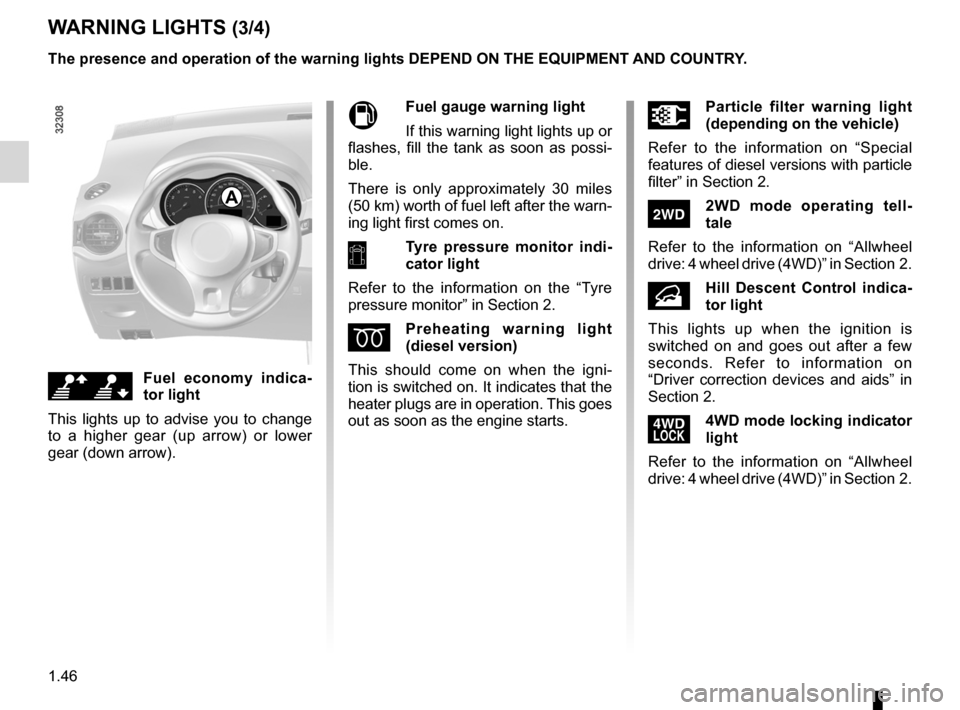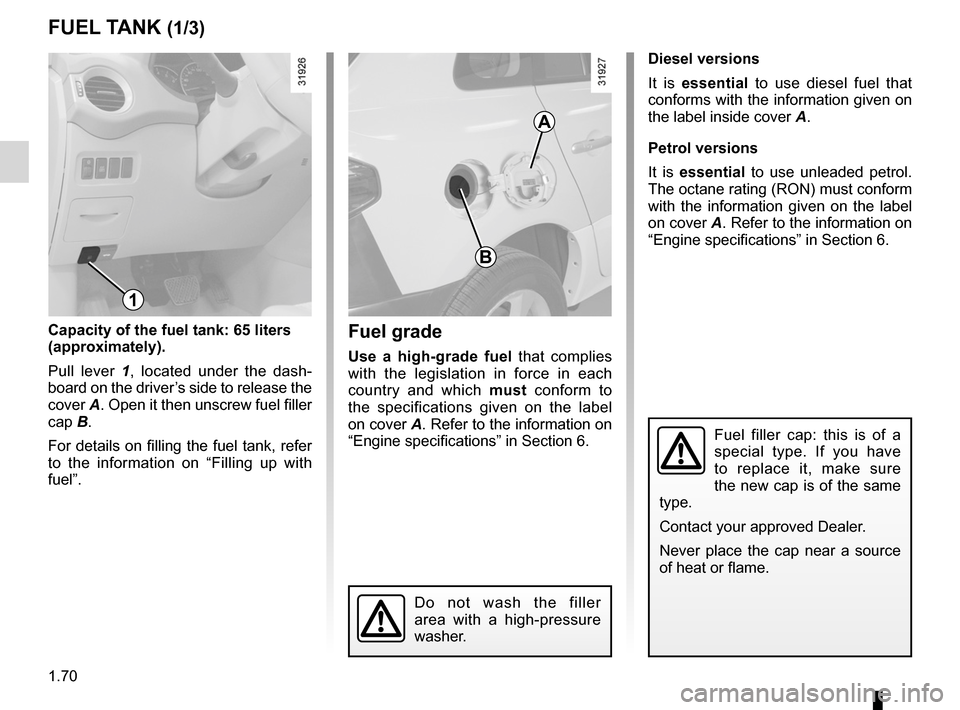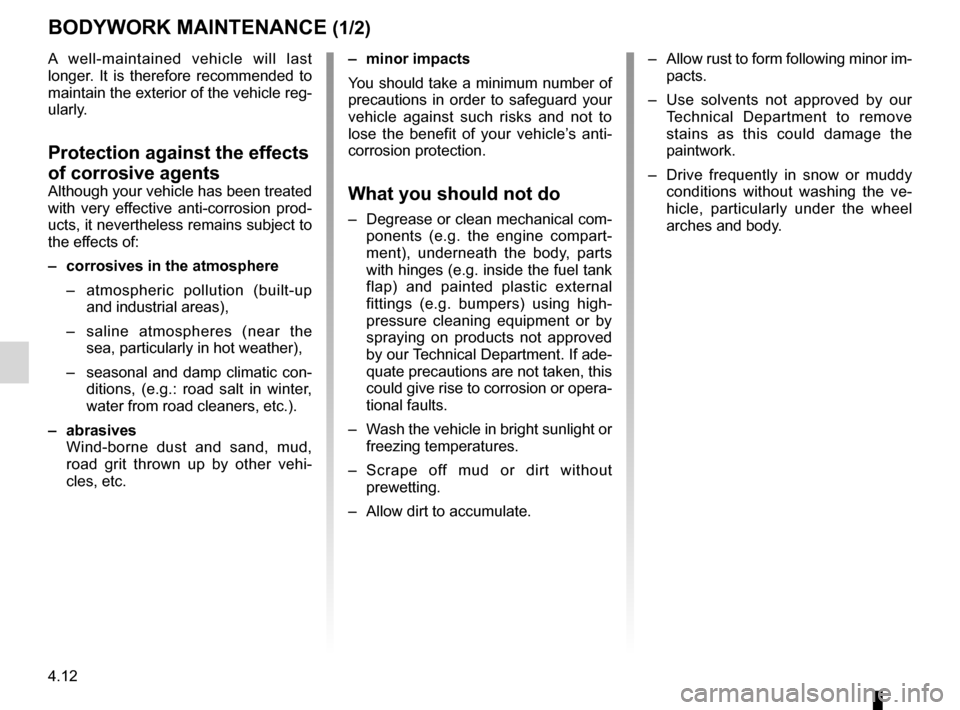fuel pressure RENAULT KOLEOS 2012 1.G Owners Manual
[x] Cancel search | Manufacturer: RENAULT, Model Year: 2012, Model line: KOLEOS, Model: RENAULT KOLEOS 2012 1.GPages: 233, PDF Size: 7.81 MB
Page 52 of 233

fuelfilling ................................................................. (current page)
filter particle filter ..................................................... (current page)
1.46
ENG_UD23307_5
Témoins lumineux (X45 - H45 - Renault)
ENG_NU_977-2_H45_Ph2_Renault_1
Jaune NoirNoir texte
WARNINg LIghTs (3/4)
A
\[fuel economy indica -
tor light
This lights up to advise you to change
to a higher gear (up arrow) or lower
gear (down arrow).
Mfuel gauge warning light
If this warning light lights up or
flashes, fill the tank as soon as possi -
ble.
There is only approximately 30 miles
(50 km) worth of fuel left after the warn-
ing light first comes on.
7Tyre pressure monitor indi -
cator light
Refer to the information on the “Tyre
pressure monitor” in Section 2.
Ép reheating warning light
(diesel version)
This should come on when the igni -
tion is switched on. It indicates that the
heater plugs are in operation. This goes
out as soon as the engine starts.
\fp article filter warning light
(depending on the vehicle)
Refer to the information on “Special
features of diesel versions with particle
filter” in Section 2.
‘2W d mode operating tell -
tale
Refer to the information on “Allwheel
drive: 4 wheel drive (4WD)” in Section 2.
•h ill descent control indica -
tor light
This lights up when the ignition is
switched on and goes out after a few
seconds. Refer to information on
“Driver correction devices and aids” in
Section 2.
’4Wd mode locking indicator
light
Refer to the information on “Allwheel
drive: 4 wheel drive (4WD)” in Section 2.
The presence and operation of the warning lights dEpENd ON ThE EQUIpMENT ANd cOUNTRY.
Page 76 of 233

fuel tank capacity .................................. (up to the end of the DU)
fuel capacity ........................................... (up to the end of the DU)
fuel filling ................................................ (up to the end of the DU)
fuel grade ............................................... (up to the end of the DU)
fuel tank capacity ........................................... (up to the end of the DU)
fuel filler cap ......................................... (up to the end of the DU)
1.70
ENG_UD23493_6
Réservoir carburant (X45 - H45 - Renault)
ENG_NU_977-2_H45_Ph2_Renault_1
Jaune NoirNoir texte
Fuel tank
fUEL TANK (1/3)
capacity of the fuel tank: 65 liters
(approximately).
Pull lever 1 , located under the dash -
board on the driver’s side to release the
cover A. Open it then unscrew fuel filler
cap B.
For details on filling the fuel tank, refer
to the information on “Filling up with
fuel”.fuel grade
Use a high-grade fuel that complies
with the legislation in force in each
country and which must conform to
the specifications given on the label
on cover A. Refer to the information on
“Engine specifications” in Section 6.
1
A
B
diesel versions
It is essential to use diesel fuel that
conforms with the information given on
the label inside cover A.
petrol versions
It is essential to use unleaded petrol.
The octane rating (RON) must conform
with the information given on the label
on cover A. Refer to the information on
“Engine specifications” in Section 6.
Do not wash the filler
area with a high-pressure
washer.
Fuel filler cap: this is of a
special type. If you have
to replace it, make sure
the new cap is of the same
type.
Contact your approved Dealer.
Never place the cap near a source
of heat or flame.
Page 79 of 233

2.1
ENG_UD27164_2
Contents 2 (X45 - H45 - Renault)
ENG_NU_977-2_H45_Ph2_Renault_2
Section 2: Driving
(Advice on use relating to fuel economy and the environment)
Running in . . . . . . . . . . . . . . . . . . . . . . . . . . . . . . . . . . . . . . . . . . . . . . . . . . . . . . . . . . . . . . . . . . . . . 2.2
Starting the engine . . . . . . . . . . . . . . . . . . . . . . . . . . . . . . . . . . . . . . . . . . . . . . . . . . . . . . . . . . . . . . 2.3
Stopping the engine . . . . . . . . . . . . . . . . . . . . . . . . . . . . . . . . . . . . . . . . . . . . . . . . . . . . . . . . . . . . . . 2.5
Special features of petrol versions . . . . . . . . . . . . . . . . . . . . . . . . . . . . . . . . . . . . . . . . . . . . . . . . . . 2.6
Special features of diesel versions . . . . . . . . . . . . . . . . . . . . . . . . . . . . . . . . . . . . . . . . . . . . . . . . . . 2.7
Special features of diesel versions fitted with a particle filter . . . . . . . . . . . . . . . . . . . . . . . . . . . . . . 2.8
Gear lever . . . . . . . . . . . . . . . . . . . . . . . . . . . . . . . . . . . . . . . . . . . . . . . . . . . . . . . . . . . . . . . . . . . . . 2.9
Handbrake . . . . . . . . . . . . . . . . . . . . . . . . . . . . . . . . . . . . . . . . . . . . . . . . . . . . . . . . . . . . . . . . . . . . . 2.9
Electronic parking brake . . . . . . . . . . . . . . . . . . . . . . . . . . . . . . . . . . . . . . . . . . . . . . . . . . . . . . . . . . 2.10
Advice: antipollution and fuel economy . . . . . . . . . . . . . . . . . . . . . . . . . . . . . . . . . . . . . . . . . . . . . . . 2.14
Environment . . . . . . . . . . . . . . . . . . . . . . . . . . . . . . . . . . . . . . . . . . . . . . . . . . . . . . . . . . . . . . . . . . . 2.17
Tyre pressure monitor . . . . . . . . . . . . . . . . . . . . . . . . . . . . . . . . . . . . . . . . . . . . . . . . . . . . . . . . . . . . 2.18
All-wheel drive transmission: 4-wheel drive (4WD) . . . . . . . . . . . . . . . . . . . . . . . . . . . . . . . . . . . . . . 2.21
Driver correction devices . . . . . . . . . . . . . . . . . . . . . . . . . . . . . . . . . . . . . . . . . . . . . . . . . . . . . . . . . . 2.24
Speed limiter . . . . . . . . . . . . . . . . . . . . . . . . . . . . . . . . . . . . . . . . . . . . . . . . . . . . . . . . . . . . . . . . . . . 2.29
Cruise control . . . . . . . . . . . . . . . . . . . . . . . . . . . . . . . . . . . . . . . . . . . . . . . . . . . . . . . . . . . . . . . . . . 2.32
Parking sensor . . . . . . . . . . . . . . . . . . . . . . . . . . . . . . . . . . . . . . . . . . . . . . . . . . . . . . . . . . . . . . . . . . 2.36
Automatic or continuously variable transmission . . . . . . . . . . . . . . . . . . . . . . . . . . . . . . . . . . . . . . . . 2.39
Page 170 of 233

maintenance:bodywork ........................................ (up to the end of the DU)
washing ................................................ (up to the end of the DU)
paintwork maintenance ................................... (up to the end of the DU)
anti-corrosion protection ....................... (up to the end of the DU)
cleaning: outside the vehicle .......................... (up to the end of the DU)
4.12
ENG_UD22865_9
Entretien de la carrosserie (X45 - H45 - J77 - X81 - X85 - B85 - C85 - S85 - X91 - B91 - K91 - D91 - X83 - X61 - X77 ph2 - K85 - X95 - B95 - D95 - K95 - J95 - R95 - L38 -
ENG_NU_977-2_H45_Ph2_Renault_4
Jaune NoirNoir texte
Bodywork maintenance
BODyWORk MAIntenAnCe (1/2)
– Allow rust to form following minor im-
pacts.
– Use solvents not approved by our
Technical Department to remove
stains as this could damage the
paintwork.
– Drive frequently in snow or muddy
conditions without washing the ve -
hicle, particularly under the wheel
arches and body.
–
minor impacts
You should take a minimum number of
precautions in order to safeguard your
vehicle against such risks and not to
lose the benefit of your vehicle’s anti -
corrosion protection.
What you should not do
– Degrease or clean mechanical com-
ponents (e.g. the engine compart -
ment), underneath the body, parts
with hinges (e.g. inside the fuel tank
flap) and painted plastic external
fittings (e.g. bumpers) using high-
pressure cleaning equipment or by
spraying on products not approved
by our Technical Department. If ade-
quate precautions are not taken, this
could give rise to corrosion or opera-
tional faults.
– Wash the vehicle in bright sunlight or
freezing temperatures.
– Scrape off mud or dirt without
prewetting.
– Allow dirt to accumulate.
A well-maintained vehicle will last
longer. It is therefore recommended to
maintain the exterior of the vehicle reg-
ularly.
protection against the effects
of corrosive agents
Although your vehicle has been treated
with very effective anti-corrosion prod
-
ucts, it nevertheless remains subject to
the effects of:
– corrosives in the atmosphere
– atmospheric pollution (built-up
and industrial areas),
– saline atmospheres (near the
sea, particularly in hot weather),
– seasonal and damp climatic con-
ditions, (e.g.: road salt in winter,
water from road cleaners, etc.).
– abrasives
Wind-borne dust and sand, mud,
road grit thrown up by other vehi -
cles, etc.